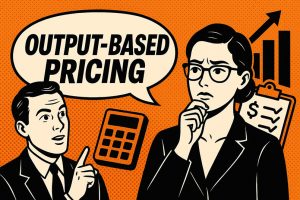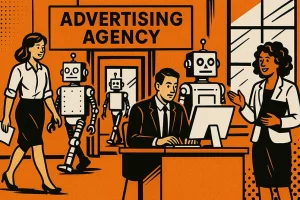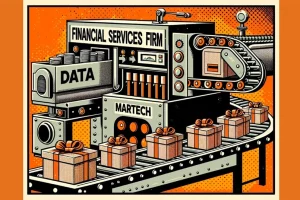Unlike a blog, this is not a collection of musings or things that caught our attention today.
Instead, it is a collection of the important insights, trends and issues we have encountered in our work with our clients and the solutions we have developed.
This why we call it our Knowledge Centre. It is where we share the collective knowledge of TrinityP3. We add to this regularly. We update it when and where needed. We recommend bookmarking this page and be sure to visit regularly when looking for inspiration, insight and knowledge on the world of marketing management.
Our Latest Articles

How output pricing supports an agency subscription fee model
While input models, such as hourly rates, retainers and project fees, continue to dominate agency fees, there is an increasing interest in output-based pricing models, driven primarily by the impact of AI technology on agency productivity. However, several issues affecting ...

What are the real considerations and impacts of AI on agency fees?
An increasing number of agencies are including promises of AI benefits in their pitches. Typically, these are framed in the context of improved productivity through automation, allowing the agency to provide more for less. A.K.A. - savings. This is a ...

Navigating the chaos – how to avoid the marketing traps around technology, data and measurement
For marketers, the spectacular promise of data, technology and now AI has never been greater, but nor has the complexity. The tech industry and media headlines constantly promise marketers to become more “streamlined” and “empowered”. Yes, the experience of many ...
Most Popular Articles

What is the definition of Marketing?
I was the guest lecturer for the EMBA course at the Sydney Business School, University of Wollongong for several years. The topic title was marketing today, and I was interested to know how this group of business executives and tomorrow’s ...

The Top 10 Ethical Issues for Marketers in 2024
Stay ahead of the curve in ethical marketing practice with this comprehensive guide from TrinityP3 to the top ethical issues facing the industry and how to navigate them with integrity. What is ethical marketing and why does it matter? Here ...

Agency selection criteria – seven things to consider when choosing an advertising agency
Choosing a new advertising agency, be that creative, media, digital, experiential, shopper, pr or any one of the many other types of service providers is not something to be taken lightly. The cost and time involved and the impact on ...

The difference Between Scope of Work (SoW) and Scope of Services (SoS), and why that matters
We have talked and written many times about the importance of the scope of work in regard to setting or benchmarking agency remuneration based on productivity and not simply the cost of resources. But there is often confusion in regard ...

What are the biggest issues facing the media industry?
Media advertising continues to be the most significant single component of most advertisers' marketing budgets. Paid media is a substantial investment across traditional media and, increasingly, into digital channels, which are eclipsing traditional broadcast media channels. However, with this change ...

Top ways to make agencies more effective in presenting their credentials
For the past 20 years, I have literally sat through more than a thousand agency credentials presentations. Some were part of a pitch or tender credentials presentation, and others were when I was engaged in providing feedback to help agencies ...
Browse all our insights

How output pricing supports an agency subscription fee model
While input models, such as hourly rates, retainers and project fees, continue to dominate agency fees, there is an increasing interest in output-based pricing models, driven primarily by the impact of AI technology on agency productivity. However, several issues affecting ...

What are the real considerations and impacts of AI on agency fees?
An increasing number of agencies are including promises of AI benefits in their pitches. Typically, these are framed in the context of improved productivity through automation, allowing the agency to provide more for less. A.K.A. - savings. This is a ...

Navigating the chaos – how to avoid the marketing traps around technology, data and measurement
For marketers, the spectacular promise of data, technology and now AI has never been greater, but nor has the complexity. The tech industry and media headlines constantly promise marketers to become more “streamlined” and “empowered”. Yes, the experience of many ...

The perils of counting chickens: Why agencies shouldn’t bank on new business revenue
In the fiercely competitive advertising industry, agencies are increasingly using aggressive financial forecasting to sidestep making crucial operational decisions vital to their future. One common but flawed practice is incorporating significant new business revenue into their financial modelling, often exaggerated ...

Review of Martech and Adtech stack requirements and performance for a Beverages advertiser – Case study
Challenging Problem “Can you advise us on whether we have the right adtech and martech in our stack?” “What’s the most effective measure of social media now to show that we’re moving the dial on sales growth?” “What are the ...

Advising a Financial Services company on their Martech and Data for customer engagement – Case Study
Challenging problem TrinityP3 is not always known for independent advisory on marketing and advertising technology. However, over the past 18 months we have been helping more and more marketers optimise their approach to martech and adtech as an enabler of ...

The importance of positioning in-house agencies within your organisation
In-housing of agency services has become ubiquitous in the past decade, with their own industry associations, their own award shows and even their own industry research to demonstrate how popular and every day they have become. According to Kantar, 78% ...

The perils of agency hourly pricing: Lessons from a man and his lawn mower
Imagine sitting at lunch with some of Australia’s best marketing management consultants, watching a man spend almost five hours mowing a lawn the size of a billiard table. Is this a tale of dedication or a cautionary editorial on the ...

How to avoid waste in your agency fees
With the increase in the cost of living still impacting households in most of the world’s economies, it only stands to reason that businesses will be equally impacted as consumers tighten their belts. In the last few months, we have ...

Assessing Media Agency Contracts – Case Study
Challenging Problem Media agency contracts can be complex and, due to the evolution of media strategies, channel investments and technology, can ‘date’ relatively quickly. While most organisations have in-house legal and procurement expertise, they are often not specifically experienced in ...

Reviewing Media Agency Commercial Arrangements for the Financial Services Sector – Case Study
Challenging Problem This organization operated in a highly decentralized structure whilst using one media agency. The challenges that the client wished to address in this project included: Establishing a consistent operating practice Agency governance Understanding strengths and challenges of current ...

Media Agency Pitch Management for the Higher Education Sector – Case study
Challenging Problem Our client had been working with a respected agency partner in a long-term relationship. However, there was an internal requirement to stress-test the market when the pace of change in the organisation increased, which necessitated rapid evolution of ...
Our Latest Podcast:

Managing Marketing: Transforming Marketing Charity – The Sydney Children’s Hospital Foundation
Kate Ferguson, CMO of the Sydney Children's Hospital Foundation, discusses the transformative strategies implemented there, focusing on integrated fundraising efforts, emotional storytelling, and innovative partnerships. She highlights the significant impact of their campaigns, the importance of connecting with donors through authentic narratives, and the future aspirations for pediatric healthcare. Additionally, ...
